
Lyman Frank Baum was an American author best known for his children's books, particularly The Wonderful Wizard of Oz and its sequels. He wrote 14 novels in the Oz series, plus 41 other novels, 83 short stories, over 200 poems, and at least 42 scripts. He made numerous attempts to bring his works to the stage and screen; the 1939 adaptation of the first Oz book became a landmark of 20th-century cinema.

The Wonderful Wizard of Oz is an American children's novel written by author L. Frank Baum and illustrated by W. W. Denslow. The first novel in the Oz series, the story chronicles the adventures of a young Kansas farm girl named Dorothy in the magical Land of Oz after she and her pet dog Toto are swept away from their home by a tornado. Upon her arrival in Oz, she learns she cannot return home until she has destroyed the Wicked Witch of the West.

The Emerald City of Oz is the sixth of L. Frank Baum's fourteen Land of Oz books. It was also adapted into a Canadian animated film in 1987. Originally published on July 20, 1910, it is the story of Dorothy Gale and her Uncle Henry and Aunt Em coming to live in Oz permanently. While they are toured through the Quadling Country, the Nome King is assembling allies for an invasion of Oz. This is the first time in the Oz series that Baum made use of double plots for one of the books.

The Marvelous Land of Oz: Being an Account of the Further Adventures of the Scarecrow and the Tin Woodman, commonly shortened to The Land of Oz, published in July 1904, is the second of L. Frank Baum's books set in the Land of Oz, and the sequel to The Wonderful Wizard of Oz (1900). This and the next 34 Oz books of the famous 40 were illustrated by John R. Neill. The book was made into an episode of The Shirley Temple Show in 1960, and into a Canada/Japan co-produced animated series of the same name in 1986. It was also adapted in comic book form by Marvel Comics; once in 1975 in the Marvel Treasury of Oz series, and again in an eight issue series with the first issue being released in November 2009. Plot elements from The Marvelous Land of Oz are included in the 1985 Disney feature film Return to Oz.

Dorothy Gale is a fictional character created by American author L. Frank Baum as the protagonist in many of his Oz novels. She first appears in Baum's classic 1900 children's novel The Wonderful Wizard of Oz and reappears in most of its sequels. In addition, she is the main character in various adaptations, notably the classic 1939 film adaptation of the novel, The Wizard of Oz.

Princess Ozma is a fictional character from the Land of Oz, created by American author L. Frank Baum. She appears in every book of the Oz series except the first, The Wonderful Wizard of Oz (1900).
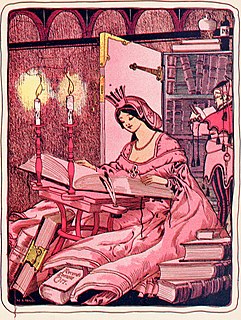
Glinda is a fictional character created by L. Frank Baum for his Oz novels. She first appears in Baum's 1900 children's classic The Wonderful Wizard of Oz, and is the most powerful sorceress in the Land of Oz, ruler of the Quadling Country South of the Emerald City, and protector of Princess Ozma.

The Land of Oz is a magical country first introduced in the 1900 children's novel The Wonderful Wizard of Oz written by L. Frank Baum and illustrated by W. W. Denslow.

The Good Witch of the North, sometimes named Locasta or Tattypoo, is a fictional character in the Land of Oz, created by American author L. Frank Baum. She is the elderly and mild-mannered Ruler of the Gillikin Country. Her only significant appearance in Baum's work is in Chapter 2 of The Wonderful Wizard of Oz (1900), in which she introduces Dorothy to Oz and sends her to meet the Wizard, after placing a protective kiss on her forehead. She makes a brief cameo appearance at Princess Ozma's birthday party in The Road to Oz (1909), but is otherwise only mentioned elsewhere in the series.

The Shaggy Man of Oz (1949) is the thirty-eighth in the series of Oz books created by L. Frank Baum and his successors, and the second and last by Jack Snow. It was illustrated by Frank G. Kramer. The book entered the public domain in the United States when its copyright was not renewed as required.
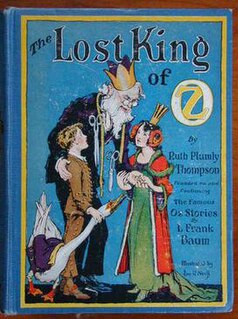
King Pastoria is a fictional character mentioned in the Oz books by American author L. Frank Baum. He was the rightful ruler and King of the undiscovered Land of Oz, but was mysteriously removed from his position when the Wizard of Oz unexpectedly came to the country and took the throne, proclaiming himself as the new dominant ruler of Oz. Shortly after, Pastoria's only child and heir, Princess Ozma, suddenly vanished, leaving not a single clue of her whereabouts.

Jellia Jamb is a fictional character from the classic children's series of Oz books by American author L. Frank Baum. She is first introduced in The Wonderful Wizard of Oz (1900), as the head maid who works in the royal palace of the Emerald City which is the imperial capital of the Land of Oz. In later books, Jellia eventually becomes Princess Ozma's favorite servant out of the Emerald City's staff administration. She is also the protagonist of Ruth Plumly Thompson's novel Ozoplaning with the Wizard of Oz. Her name is a pun on the phrase "Jelly or jam?"

The Wicked Witch of Oz is a novel by Rachel Cosgrove Payes. Written in the early 1950s but not published until four decades later, the book is a volume in the series of Oz books by L. Frank Baum and his successors.
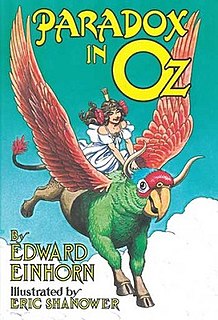
Paradox in Oz is a 1999 novel written by Edward Einhorn. As its title indicates, the book is an entry in the series of books about the Land of Oz written by L. Frank Baum and a host of successors.

Little Wizard Stories of Oz is a set of six short stories written for young children by L. Frank Baum, the creator of the Oz books. The six tales were published in separate small booklets, "Oz books in miniature," in 1913, and then in a collected edition in 1914 with illustrations by John R. Neill. Each booklet is 29 pages long, and printed in blue ink rather than black.
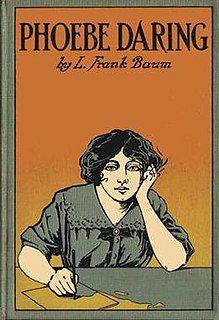
Phoebe Daring: A Story for Young Folk is a mystery novel for juvenile readers, written by L. Frank Baum, the author of the Oz books. Published in 1912, it was a sequel to the previous year's The Daring Twins, and the second and final installment in a proposed series of similar books. Phoebe Daring was illustrated by Joseph Pierre Nuyttens, the artist who illustrated Baum's The Flying Girl, Annabel, and The Flying Girl and Her Chum in the same period. Hungry Tiger Press announced that they would reprint the book as Unjustly Accused! in the back of their 2006 reprint of the first book as The Secret of the Lost Fortune.
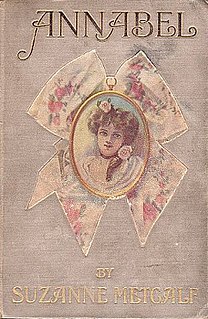
Annabel: A Novel for Young Folk is a 1906 juvenile novel written by L. Frank Baum, the author famous for his series of books on the Land of Oz. The book was issued under the pen name "Suzanne Metcalf," one of Baum's various pseudonyms. Annabel was one of Baum's first efforts to write a novel for adolescent girls – who soon became one of his most important audiences.
The Tik-Tok Man of Oz is a musical play with book and lyrics by L. Frank Baum and music by Louis F. Gottschalk that opened at the Majestic Theatre in Los Angeles, California on March 31, 1913. It is loosely inspired by Baum's book Ozma of Oz (1907), incorporates much of the material from Baum's book The Road to Oz (1909), and was the basis for his 1914 novel, Tik-Tok of Oz. It was promoted as "A Companion Play to The Wizard of Oz" and directed by Frank M. Stammers. The play is known from its advertising and published music, but survives only in earlier manuscript.
This is a complete bibliography for American children's writer L. Frank Baum.

















